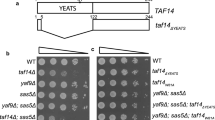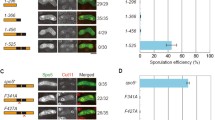Abstract
The SGA/TFC complex plays an important role in the regulation of transcription. We have examined the significance of the gene positioning in the nucleus for its transcription and subsequent export of nascent mRNA. It was demonstrated that E(y)2 protein was a subunit of the SAGA/TFTC histone acetyl transferase complex in Drosophila and that E(y)2 concentrated at the nuclear periphery. An interaction between E(y)2 and the nuclear pore complex (NPC) was demonstrated, as well as that SAGA/TFTC also contacted the NPC at nuclear periphery. In addition, it was shown that NPC formed complex with the Xmas-2 protein (X-linked male sterile 2) both in normal conditions and after heat shock. Importantly, the E(y)2 and Xmas-2 knockdown decreased the contact between the heat-shock protein 70 (hsp70) gene loci and the nuclear envelope before and after activation, which interfered with the transcription. Thus, E(y)2 and Xmas-2 together with SAGA/TFTC functioned in the anchoring of a subset of transcription sites to the NPCs to achieve efficient transcription and mRNA export.
Similar content being viewed by others
References
Cockell, M. and Gasser, S.M., Nuclear Compartments and Gene Regulation, Curr. Opin. Genet., 1999, vol. 9, pp. 199–205.
Zink, D., Amaral, M.D., Englmann, A., et al., Transcription-Dependent Spatial Arrangements of CFTR and Adjacent Genes in Human Cell Nuclei, J. Cell Biol., 2004, vol. 166, pp. 815–825.
Pickersgill, H., Kalverda, B., de Wit, E., et al., Characterization of the Drosophila melanogaster Genome at the Nuclear Lamina, Nat. Genet., 2006, vol. 38, pp. 1005–1014.
Ishii, K., Arib, G., Lin, C., et al., Chromatin Boundaries in Budding Yeast: The Nuclear Pore Connection, Cell, 2002, vol. P, pp. 551–562.
Dantonel, J.C., Murthy, K.G., Manley, J.L., and Tora, L., Transcription Factor TFIID Recruits Factor CPSF for Formation of 3′ End of mRNA, Nature, 1997, vol. 389, pp. 399–402.
Fischer, T., Strasser, K., Racz, A., et al., The mRNA Export Machinery Requires the Novel Sac3p-Thp1p Complex to Dock at the Nucleoplasmic Entrance of the Nuclear Pores, EMBO J., 2002, vol. 21, pp. 5843–5852.
Gallardo, M. and Aguilera, A., A New Hyperrecombination Mutation Identifies a Novel Yeast Gene, THP1, Connecting Transcription Elongation with Mitotic Recombination, Genetics, 2001, vol. 157, pp. 79–89.
Georgiev, P.G., Identification of Mutations in Three Genes That Interact with Zeste in the Control of White Gene Expression in Drosophila melanogaster, Genetics, 1994, vol. 138, pp. 733–739.
Georgieva, S., Nabirochkina, E., Dilworth, F.J., et al., The Novel Transcription Factor e(y)2 Interacts with TAF(II)40 and Potentiates Transcription Activation on Chromatin Templates, Mol. Cell. Biol., 2001, vol. 21, pp. 5223–5231.
Muratoglu, S., Georgieva, S., Papai, G., et al., Two Different Drosophila ADA2 Homologues Are Present in Distinct GCN5 Histone Acetyltransferase-Containing Complexes, Mol. Cell. Biol., 2003, vol. 23, pp. 306–321.
Pankotai, T., Komonyi, O., Bodai, L., et al., The Homologous Drosophila Transcriptional Adapters ADA2a and ADA2b Are Both Required for Normal Development but Have Different Functions, Mol. Cell. Biol., 2005, vol. 25, pp. 8215–8227.
Rodriguez-Navarro, S., Fischer, T., Luo, M.J., et al., Two Different Drosophila ADA2 Homologues Are Present in Distinct GCN5 Histone Acetyltransferase-Containing Complexes, Cell, 2004, vol. 116, pp. 75–86.
Wanker, E.E., Rovira, C., Scherzinger, E., et al., HIP-I: A Huntingtin Interacting Protein Isolated by the Yeast Two-Hybrid System, Hum. Mol. Genet., 1997, vol. 6, pp. 487–495.
Clemens, J.C., Worby, C.A., Simonson-Leff, N., et al., Use of Double-Stranded RNA Interference in Drosophila Cell Lines to Dissect Signal Transduction Pathways, Proc. Natl. Acad. Sci. USA, 2000, vol. 97, pp. 6499–6503.
Georgieva, S., Kirschner, D.B., Jagla, T., et al., Two Novel Drosophila TAF(II)s Have Homology with Human TAF(II)30 and Are Differentially Regulated during Development, Mol. Cell. Biol., 2000, vol. 20, pp. 1639–1648.
Lebedeva, L.A., Nabirochkina, E.N., Kurshakova, M.M., et al., Occupancy of the Drosophila hsp70 Promoter by a Subset of Basal Transcription Factors Diminishes upon Transcriptional Activation, Proc. Natl. Acad. Sci. USA, 2005, vol. 102, pp. 18087–18092.
Platero, J.S., Sharp, E.J., Adler, P.N., et al., In vivo Assay for Protein-Protein Interactions Using Drosophila Chromosomes, Chromosoma, 1996, vol. 104, pp. 393–404.
Tokuyasu, K.T., Immunochemistry on Ultrathin Frozen Sections, Histochem. J., 1980, vol. 12, pp. 381–403.
Hediger, F., Taddei, A., Neumann, F.R., et al., Methods for Visualizing Chromatin Dynamics in Living Yeast, Methods Enzymol., 2004, vol. 375, pp. 345–365.
Taddei, A., Hediger, F., Neumann, F.R., et al., Separation of Silencing from Perinuclear Anchoring Functions in Yeast Ku80, Sir4 and Esc1 Proteins, EMBO J., 2004, vol. 23, pp. 1301–1312.
Zhimulev, I.F., Genetic Organization of Polytene Chromosomes, Adv. Genet., 1999, vol. 39, pp. 1–589.
Taddei, A., Van, H.G., Hediger, F., et al., Nuclear Pore Association Confers Optimal Expression Levels for an Inducible Yeast Gene, Nature, 2006, vol. 441, pp. 774–778.
Author information
Authors and Affiliations
Corresponding author
Additional information
Original Russian Text © M.M. Kurshakova, D.V. Kopytova, E.N. Nabirochkina, Yu.V. Nikolenko, Yu.V. Shidlovskii, S.G. Georgieva, A.N. Krasnov, 2009, published in Genetika, 2009, Vol. 45, No. 10, pp. 1332–1340.
Rights and permissions
About this article
Cite this article
Kurshakova, M.M., Kopytova, D.V., Nabirochkina, E.N. et al. Conservative E(y)2/Sus1 protein is the member of SAGA complex and new nuclear pore-associated complex in Drosophila . Russ J Genet 45, 1174–1181 (2009). https://doi.org/10.1134/S1022795409100044
Received:
Accepted:
Published:
Issue Date:
DOI: https://doi.org/10.1134/S1022795409100044




